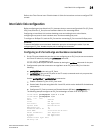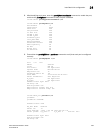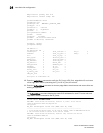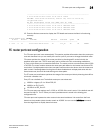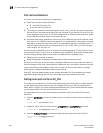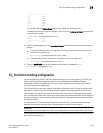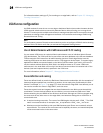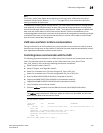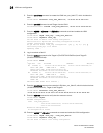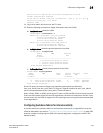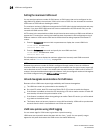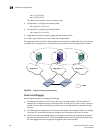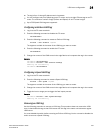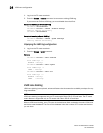
Fabric OS Administrator’s Guide 591
53-1002745-02
LSAN zone configuration
24
NOTE
The "LSAN_" prefix must appear at the beginning of the zone name. LSAN zones may not be
combined with QoS zones. Refer to “QoS zones” on page 525 for more information about the
naming convention for QoS zones.
To enable device sharing across multiple fabrics, you must create LSAN zones on the edge fabrics
(and optionally on the backbone fabric as well), using normal zoning operations to create zones
with names that begin with the special prefix “LSAN_”, and adding host and target port WWNs from
both local and remote fabrics to each local zone as desired. Zones on the backbone and on
multiple edge fabrics that share a common set of devices will be recognized as constituting a single
multi-fabric LSAN zone, and the devices that they have in common will be able to communicate
with each other across fabric boundaries.
LSAN zones and fabric-to-fabric communications
Zoning is enforced by all involved fabrics; any communication from one fabric to another must be
allowed by the zoning setup on both fabrics. If the SANs are under separate administrative control,
then separate administrators maintain access control.
Controlling device communication with the LSAN
The following procedure illustrates how LSANs control which devices can communicate with each
other. The procedure shows the creation of two LSANs (called lsan_zone_fabric75 and
lsan_zone_fabric2), which involve the following devices and connections:
• Switch1 and the host in fabric75.
• Switch2, Target A, and Target B in fabric2.
• Switch1 is connected to the FC router using an EX_Port or VEX_Port.
• Switch2 is connected to the FC router using another EX_Port or VEX_Port.
• Host has WWN 10:00:00:00:c9:2b:c9:0c (connected to switch1).
• Target A has WWN 50:05:07:61:00:5b:62:ed (connected to switch2).
• Target B has WWN 50:05:07:61:00:49:20:b4 (connected to switch2).
1. Log in as admin and connect to switch1.
2. Enter the nsShow command to list the WWN of the host (10:00:00:00:c9:2b:c9:0c).
NOTE
The nsShow output displays the LSAN zone status of a device, the port WWN, and the node
WWN; the port WWN must be used for LSANs.
switch:admin> nsshow
{
Type Pid COS PortName NodeName
TTL(sec)
N 060f00; 2,3; 10:00:00:00:c9:2b:c9:0c; 20:00:00:00:c9:2b:c9:0c; na
FC4s: FCP
NodeSymb: [35] "Emulex LP9002 FV3.91A3 DV5-5.20A6 "
Fabric Port Name: 20:0f:00:05:1e:37:00:44
Permanent Port Name: 10:00:00:00:c9:2b:c9:0c
LSAN: Yes
The Local Name Server has 1 entry }



